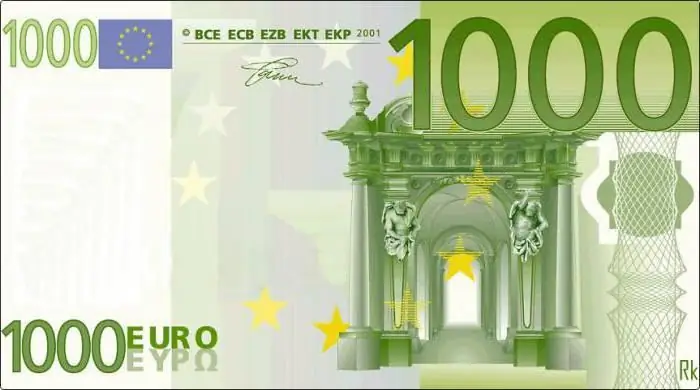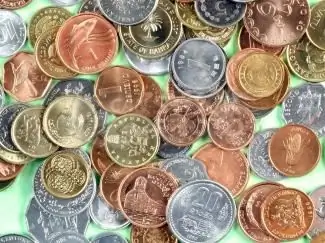2026 Author: Howard Calhoun | [email protected]. Last modified: 2025-01-24 13:10:39
Every resident of Russia constantly uses Russian rubles for any payments within the country. These are settlements with suppliers and contractors, payment for purchases in stores, payment of wages to employees, placing deposits, issuing loans, credits, etc.
The Russian ruble is the currency of the Russian Federation, as it is written in the Constitution of Russia.
What is the exchange rate?
Besides the ruble, there are more than 150 other currencies in the world. Everyone who had to go abroad or buy goods for foreign currency had to exchange Russian rubles for the necessary banknotes of another state according to a certain ratio.
The cost of the Russian ruble, denominated in a certain number of monetary units of another country, is called the exchange rate, that is, the exchange rate of the ruble against this currency. For example, 1 ruble=0.016 US dollar. This is the exchange rate of the Russian Federation to the US dollar. Although it is more common for everyone to perceive the exchange rate of the dollar against the ruble because of the relative cheapness of the latter. The exchange rate is also called its quote.
Bank exchange rate of the ruble
Determination of the official exchange rateruble to other currencies is handled by the Central Bank of the Russian Federation (CB RF). The main working currency of the Central Bank of the Russian Federation is the Russian ruble.

The Bank is the main regulator of the national currency rate and controls it, avoiding sharp fluctuations. The rate is formed with an accuracy of 4 decimal places. Such accuracy is important when converting, exchanging currencies in the amount of hundreds of thousands of units or more. Commercial banks of the Russian Federation form their rates based on the rate of the Central Bank.
Exchange exchange rate of the ruble
The Central Bank is one of the active participants in daily currency trading on the Moscow Exchange (Moex, Moscow Exchange), as well as a co-owner of this exchange. Moex is the largest stock exchange in Russia. It plays a decisive role in shaping the exchange rates of major currencies against the ruble. The ratio of supply and demand and other market factors affect the formation of the exchange rate. Bidding is conducted from 9:30 to 19:30 every day.

At about 11:30 a.m. of each working day, the exchange rates of the Central Bank of the Russian Federation are formed and the weighted average value of the ruble against the US dollar, euro and some other currencies is determined with “tomorrow” calculations.
The exchange rate on the stock exchange can be very different from the fixed rate of the Central Bank on a specific date.
Currency convertibility
One of the most significant characteristics of any currency is its convertibility, that is, the ease with which you can exchange a particular currency for any other currency in the world in any region of the world. The higherconvertibility, the easier it is to exchange one currency for another.
From this point of view, currencies are divided into:
Freely convertible. They have no restrictions on the exchange anywhere in the world. These are the currencies of the most powerful economies in the world. They are widespread and accepted everywhere. Typical representatives: US dollar, euro, Japanese yen, British pound sterling. There are approximately three and a half dozen such currencies in the world

- Partly convertible. These currencies have a limited ability to exchange and exchange well only in certain regions. These are the currencies of developing countries. These currencies include most of the monetary units of the countries of the world. The currency of the Russian Federation is a typical representative of limited convertible banknotes.
- Non-convertible. Currencies, the exchange of which is extremely difficult outside the issuing state of this money. The reason may be the weakness of the national economy of the owner of the currency, distrust of the currency and the ability of the state to meet its debts. Example: monetary units of the countries of Central Africa, Oceania.
Exchange rates on the date of the Central Bank of the Russian Federation forms regardless of the convertibility of currencies.

Types of exchange rates
There are different types of exchange rates, depending on the period of setting the rate, the method of controlling its change and the features of its calculation. Types of national currency rates are as follows:
- Cross rate. This is the determination of the exchange rate of one currency in relation to another,expressed through the exchange rate to a third currency. For example, the dollar/ruble exchange rate is 65 rubles, and the euro/ruble exchange rate is 77 rubles. This means that the cross rate of the dollar against the euro is 65/77, that is, 0.8442 euros for 1 dollar.
- Fixed on a date or period. This is officially, legislatively fixed by the Central Bank of the country, the exchange rate of the national currency in relation to a specific foreign one. It is included in government financial calculations.
- Current exchange rate. This is the price of a certain currency, based on market realities. May change daily.
- Floating rate. This is the rate that is formed on the currency exchange during the trading session.
A special type of exchange rate is a currency band. This is a situation when the Central Bank determines the maximum and minimum limits of the exchange rate of the national currency against a foreign one for a certain period and tries to ensure that the currency stays within these limits.
The exchange rates of the Central Bank of the Russian Federation for a given date can be seen at any time on the website of the Central Bank of Russia.
Factors affecting the exchange rate of the Russian Federation
A lot of factors affect the exchange rate of the Russian ruble. The main ones are listed below in descending order of influence:
- National default, that is, refusal or inability to repay debt to foreign creditors on time. In August 1998, Russia's refusal to repay its external debt led to a 4-fold collapse of the ruble against the US dollar and other currencies in just a few days.
- The country's active long-term involvement in major armed conflicts, a sharp increase in spending ondefense.
- The cost of oil on the international market. Russia is one of the largest exporters of hydrogen sulfide to the world market. From 40% to 50% of the income of the federal budget of the Russian Federation is formed from the sale of Urals oil and other brands to foreign buyers. An increase in the cost of a barrel of oil (158.978 liters) usually leads to a strengthening of the national currency. The currency of the Russian Federation is in many ways an “oil currency”.

- Conducting very large fast exchange transactions for the sale of securities of companies with the participation of state capital.
- Currency interventions of the Central Bank of Russia. To maintain or weaken the ruble exchange rate, the Central Bank sells or buys the necessary currency on the Moscow Exchange.
- The actions of non-state market participants to purchase or sell very large amounts of currency during the trading session.
- Introduction by the US or the European Union of economic sanctions against key Russian individuals and legal entities. The currency of the Russian Federation “feels” this very clearly and quickly on its course.
- Inspirational speeches by the national leader. Usually lead to a slight strengthening of the ruble.
Also, the negative or positive trade balance of the country has a significant impact on the exchange rate of any currency.
The national currency is the blood of the state's economy. Its shortage or problems with its circulation and exchange will lead the national economy to catastrophic consequences. This is a fragile and delicate tool for managing the economy,which can greatly improve or completely destroy it.
Recommended:
St. 154 of the Tax Code of the Russian Federation with comments. P. 1, Art. 154 Tax Code of the Russian Federation

St. 154 of the Tax Code of the Russian Federation determines the procedure for establishing the tax base in the process of providing services, selling goods or performing work. In the norm, special attention is paid to different ways of its formation, which the payer must choose in accordance with the terms of sale
Turkish currency and its significance for the Russian Federation

This article describes one of the options for countering the expansion of sodomy from the countries of liberal Europe through partnerships with rapidly gaining authority, but not yet very friendly to us Turkey
The EU currency is the euro. Course history. Introduction of the currency

The EU currency is the euro. The introduction of the monetary unit. Initial quotes of the new currency and existing national symbols of the EU countries
What is a currency? Russian currency. Dollar currency

What is the state currency? What does currency turnover mean? What needs to be done to make the Russian currency freely convertible? What currencies are classified as world currencies? Why do I need a currency converter and where can I find it? We answer these and other questions in the article
How is the exchange rate of the Central Bank of the Russian Federation formed, on Forex and on the MICEX?

The exchange rate is constantly in a state of fluctuation, therefore, in order to avoid financial and economic risks, it is necessary to understand the forecasting mechanism and the mechanism that explains how the exchange rate is formed. The article describes the factors that affect the exchange rate, the process of its formation in banks and stock exchanges

